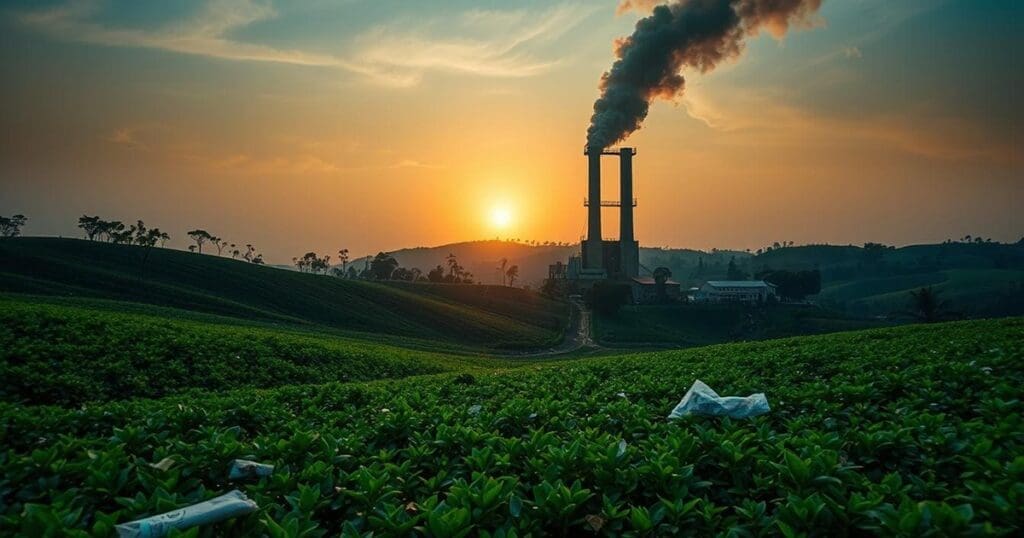Tea is the world’s favorite drink, enjoyed by millions daily. But, have you thought about its environmental impact? The tea industry affects the environment in many ways, from deforestation to water pollution. With a market value over $50 billion, it’s key to look at how tea farming impacts the planet and find ways to farm sustainably.
The tea industry’s big problem is the use of harmful chemicals. These can harm the soil and water, affecting local wildlife and people. With 2.16 billion cups of tea drunk every day, it’s vital to tackle the industry’s environmental harm. Can the tea industry meet its needs while protecting the environment through sustainable farming?
Overview of the Tea Industry
The tea industry is a big part of the global economy, with millions working in it. Tea making is hard work, from growing to packaging. The use of chemicals in tea making harms the environment.
Tea jobs support around 13 million people, with 9 million small farmers making 60% of the world’s tea. Every day, 2.16 billion cups of tea are enjoyed worldwide. Countries like China, India, Sri Lanka, and Kenya lead in tea production.
The tea industry is trying to be greener. Many tea makers use organic farming and agroforestry to help the planet. But, there’s more to do to make the industry fully green.
The tea industry is complex, with many roles. From small farmers to big estates, everyone plays a part in making tea sustainable. By focusing on green practices, the tea industry can protect our planet for the future.
The Carbon Footprint of Tea Farming
The tea industry’s carbon footprint is a big worry, with greenhouse gases causing climate change. Tea farming, the heart of the industry, is a big part of this problem. The use of pesticides, fertilizers, and other chemicals in tea growing, plus the processing and packaging, all add to the carbon footprint.
Recent data shows the global tea industry is worth over $40 billion. Smallholders make up 60% of world tea production. The carbon footprint of tea farming comes from energy for processing and packaging, and transportation emissions. 
Greenhouse Gas Emissions
Greenhouse gas emissions from tea production are a big worry. The industry’s carbon footprint is about 31.5 kg CO2e per kg of tea. Packaging, consumption, and transportation are the main causes of these emissions. The impact of packaging depends on the material used and its sustainability.
Energy Consumption in Tea Production
Energy use in tea production also adds to the industry’s carbon footprint. Energy for withering, drying, and cutting tea leaves all lead to greenhouse gas emissions. But, using sustainable practices like organic farming and agroforestry can lower the carbon footprint of tea farming. By adopting these methods, the tea industry can help make the future more sustainable.
Water Usage in Tea Cultivation
Tea farming needs a lot of water, mainly in dry areas. Water usage is key in tea farming. Tea plants need lots of water to grow. Recent data shows tea production uses a lot of water, making water conservation techniques very important.
Using drip irrigation and sprinkler systems can cut down water usage. This helps lessen the harm tea farming does to the environment. Many tea-growing places are dealing with less water, leading to the use of water-saving technologies. Some tea companies use drip irrigation to lessen their water use.
Good irrigation practices can help with water scarcity and global warming in tea farming. Tea farmers can use sustainable water management practices like rainwater harvesting and water conservation. This way, they can protect the environment and keep tea supplies steady.
Pesticide and Herbicide Use
The use of pesticides and herbicides in tea farming is a big worry. They can harm the environment and our health. Chemical impact from these substances can pollute soil and water, affecting many living things.
Studies show that pesticides and herbicides can hurt beneficial insects and pollute soil and water. This is a big problem in tea farming.
Research has found toxic chemicals in tea samples. For example, 94% of tea samples in India had pesticide residues. The pesticide use and herbicide use in tea farming can also make pests resistant to control.

The chemical impact of pesticides and herbicides is a major concern. To solve this, we need sustainable farming methods. By using fewer pesticides and herbicides, tea farmers can protect our health and the environment.
It’s important to remember that pesticides and herbicides can harm our planet for a long time. They can reduce crop and landscape diversity. So, we must use sustainable farming and cut down on these chemicals. This will help our environment and the tea industry.
Deforestation and Land Use Changes
The growth of tea plantations has caused a lot of deforestation and habitat loss, mainly in tropical areas. This is a big worry because forests cleared for tea can harm biodiversity and local wildlife.
Recent studies show that thousands of acres of forests have turned into tea farms. This is because more people want tea, leading to land use changes that harm the environment.
To tackle these issues, we can use sustainable methods like agroforestry and reforestation. These practices help save biodiversity and lessen the environmental harm from tea making. By focusing on habitat loss prevention and conservation, we aim for a greener tea industry. This way, we can grow the economy while protecting our planet.
Waste Management in the Tea Industry
The tea industry creates a lot of waste, like plastic packaging and organic waste. Proper waste management is key to lessen the environmental harm from tea making. Plastic packaging, like tea bags and sachets, adds to plastic pollution.
About 90% of tea leaves become waste after processing and drinking. This organic waste
Tea companies are working on better waste management. They’re starting recycling and composting programs. Some are even looking into biodegradable packaging to cut down on plastic use. By going green, the tea industry can help the planet and support a circular economy.
Climate Change and Its Effects on Tea
Climate change is deeply affecting the tea industry. Rising temperatures and changing rain patterns are impacting tea production globally. These changes lead to altered growing conditions, reduced yields, and lower tea quality. Studies show that even small temperature increases can reduce agricultural production in dry and tropical areas.
Tea farmers are worried about how climate change affects tea flavors and quality. Changes in rain and more flooding can dilute tea’s aromatic compounds. This affects both taste and health benefits. Tea farmers in places like Kenya face erratic rain, rising temperatures, and longer droughts. These changes harm traditional farming and tea quality.
Climate change will continue to impact tea production, leading to less tea and lower quality. To tackle these issues, the tea industry needs to adopt sustainable practices. This includes agroforestry and climate-resilient tea varieties. These steps can reduce environmental impact and ensure quality tea supply.
The tea industry must focus on sustainable practices and support farmers in adapting to growing conditions changes. By working together, we can lessen climate change’s effects on tea production. This will help secure a bright future for this cherished drink.
Sustainable Practices in Tea Farming
The global tea industry is booming, with over 2.16 billion cups consumed daily. It’s vital to use sustainable practices to lessen tea production’s environmental harm. Organic farming is a key method, helping to save biodiversity and cut down on harmful chemicals.
By picking organic tea, we support farmers who care about the planet and their workers. They focus on sustainable practices and fair labor.
Certifications like Fair Trade and Organic are important. They help ensure tea farmers get fair prices. This lets them improve their lives and farms.
So, when we drink tea, we’re backing a product made with care for the environment and people. It’s a win-win for everyone.

There are more ways to make tea farming sustainable. Tea makers can save water with smart irrigation and use green energy. These steps help the tea industry be kinder to our planet.
Consumer Awareness and Responsibility
As the global tea industry grows, consumer awareness is key. It helps promote sustainable practices and lowers the environmental impact of tea making. By choosing wisely, consumers can push the tea industry towards greener and fairer practices. More people want to buy from sustainable brands that care about fair labor and the planet.
Recent data shows that consumer awareness helps a lot in making the tea industry better. By picking sustainable brands and supporting fair work, we can lessen the harm tea making does to the environment. This way, we help make the tea world more just and green. Our choices can really make a difference in the tea industry.
Supporting sustainable brands and pushing for ethical consumerism can make the tea industry better. As more people become aware, the tea industry will likely get greener and fairer. This change is good for the planet, local communities, and the tea industry itself.
Future Challenges for the Tea Industry
The tea industry is facing big challenges. It must meet growing demand while protecting the environment. But, with new ideas and a focus on sustainability, the tea industry’s future looks bright.
New farming methods like agroforestry and organic farming can help. These approaches reduce the environmental impact of tea making. They also make tea better and meet the demand for environmentally friendly teas.
New sustainable technologies are also on the horizon. Things like biodegradable tea bags and energy-saving steps are coming. These changes will help the industry be greener, so we can enjoy tea without harming the planet.
The tea industry is on a path to a sustainable future. It needs innovators, aware consumers, and a shared goal to protect our planet. Together, we can find a balance between our needs and caring for the environment.




Facebook Comments